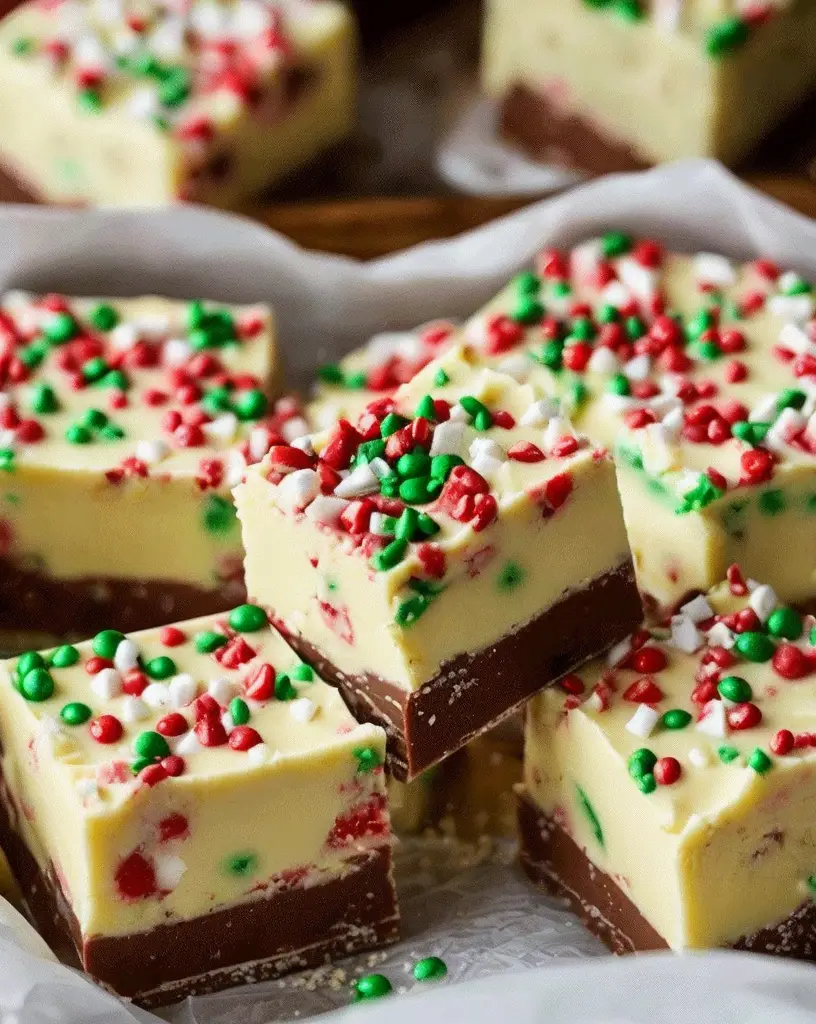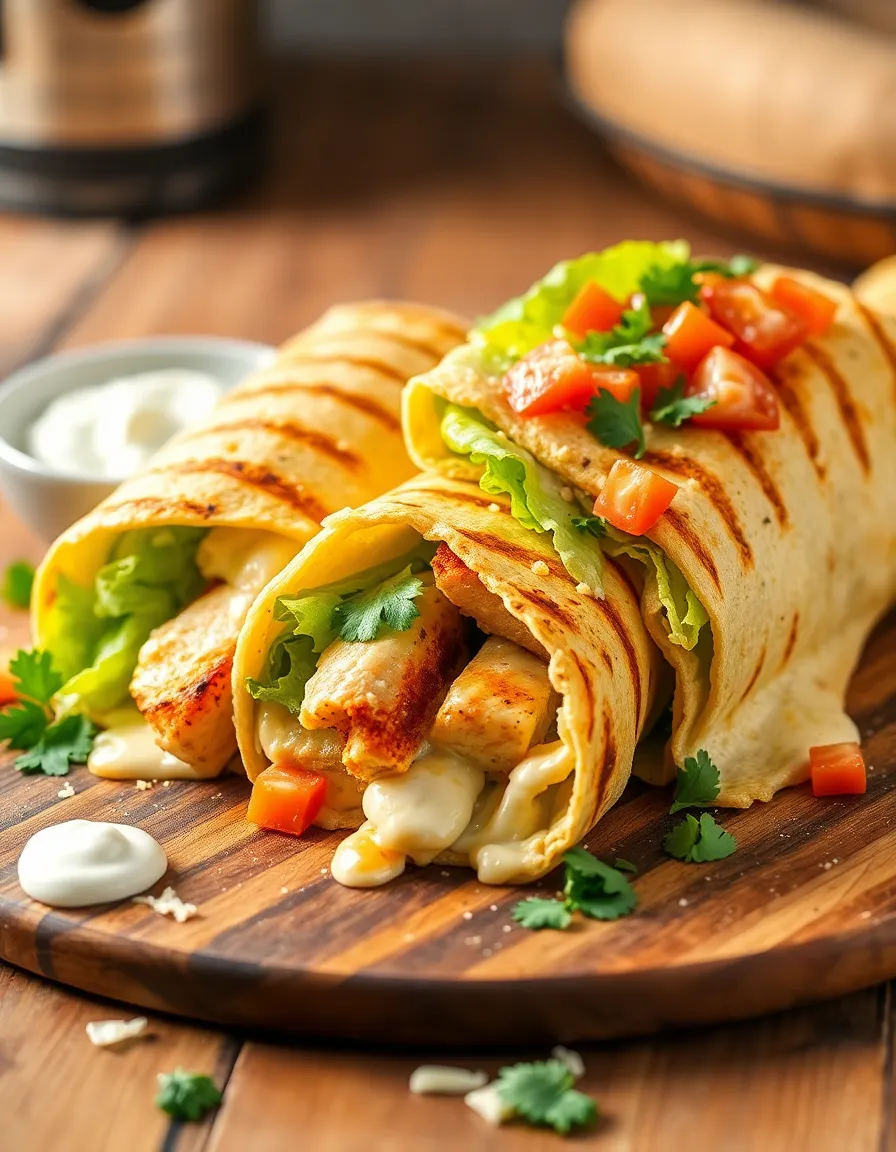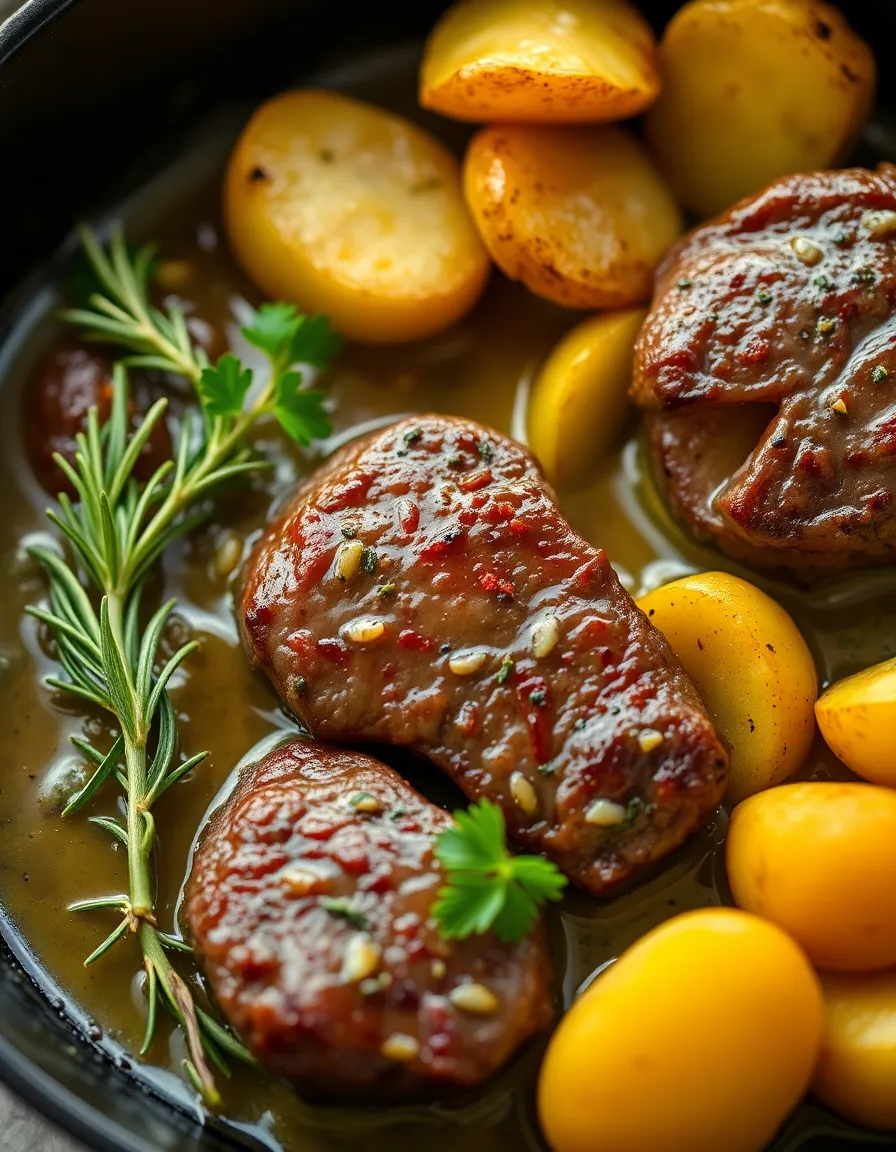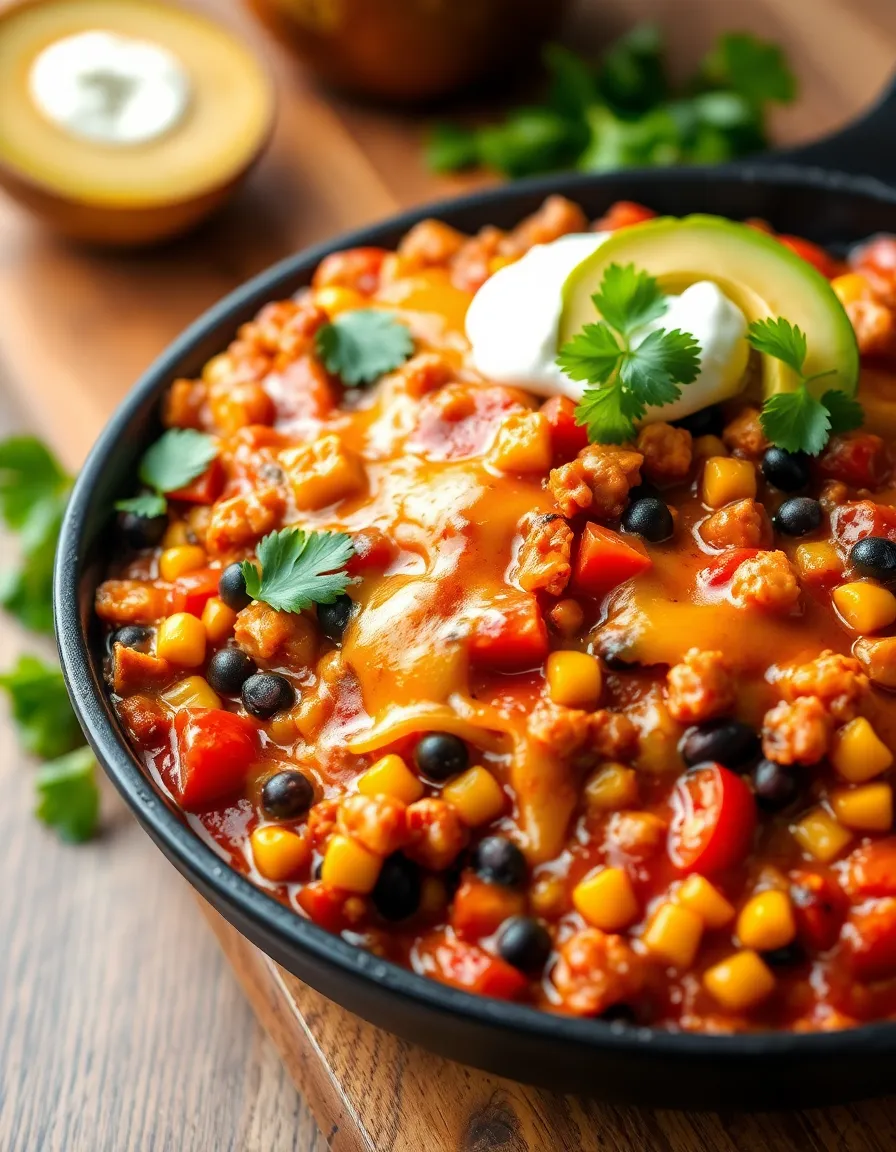Classic Christmas Fudge Recipe: A Festive Delight
Indulge in the velvety sweetness of this Classic Christmas Fudge Recipe, a festive treat that embodies the spirit of the holiday season. Every bite offers the perfect harmony of rich, creamy chocolate and a hint of vanilla, making it an irresistible indulgence. This delightful fudge is not just a dessert; it’s a cherished tradition that brings warmth and joy to your festive gatherings. Crafted with simple ingredients, it’s a no-fuss recipe that allows you to spend more quality time with loved ones while tantalizing taste buds with every morsel.
Quick Recipe Highlights
- Flavor Profile: The fudge boasts a deep, rich chocolate flavor accented by a touch of vanilla, creating a perfectly balanced sweetness that’s not overly sugary.
- Texture: Each piece of fudge melts in your mouth with its luxuriously smooth and creamy texture, offering a gratifying consistency.
- Aroma: The delightful aroma of chocolate fills the air, entwined with sweet vanilla notes that evoke memories of holiday warmth.
- Visual Appeal: The glossy, dark design of the fudge, adorned with optional nuts or sprinkles, presents an inviting festive charm on any dessert table.
- Skill Level Needed: This easy recipe requires only basic cooking skills, making it perfect for bakers of all levels, including beginners.
- Special Equipment: Aside from a sturdy saucepan and a tray, no special equipment is required, simplifying the cooking process.
Recipe Overview
- Difficulty Level: Rated as easy, this Christmas fudge recipe can be expertly executed with minimal skills, making it ideal for beginners or those short on time.
- Category: This dessert falls into the confectionery category, perfect for those who love indulging their sweet tooth during festive seasons.
- Cuisine: A timeless treat with roots in classic American cuisine, this fudge underlines the simplicity and decadence of homemade sweets.
- Cost: Affordable and accessible, the ingredients for this recipe are budget-friendly, requiring only basic pantry staples.
- Season: Christmas is the perfect time to make this fudge, capitalizing on the comfort and warmth it brings during chilly winter nights.
- Occasion: Ideal for holiday gatherings, gift-giving, and cozy family get-togethers, this fudge recipe suits any festive or celebratory occasion.
Why You’ll Love This Recipe
This Classic Christmas Fudge Recipe wins hearts with its delightful flavor and luxurious texture. Each square of fudge offers a rich chocolatey experience that satisfies even the most discerning sweet tooth. Its effortless preparation, using simple ingredients, is a boon for those seeking a quick yet impressive holiday treat. The recipe’s simplicity allows even novice bakers to succeed with ease, making it a fantastic confidence booster in the kitchen.
This fudge is perfect for busy holiday schedules due to its quick preparation time. It requires minimal ingredients and no special equipment, allowing you to whip up a batch in less than 30 minutes, leaving you more time for other holiday activities. This recipe can be easily doubled to ensure there’s enough delightful fudge for everyone.
Beyond its tempting taste, the fudge offers nutritional benefits, with a good source of energy and a comforting treat during the colder months. Its energy-boosting properties make it a great pick for a holiday treat.
Creating and sharing this fudge fosters joy and connection during social gatherings, making it a truly social dessert. It is a popular gifting option, lovingly wrapped and shared with friends and family, further spreading the festive cheer.
Cost-effective and universally loved, the ingredients for this holiday fudge are affordable and usually stocked in the kitchen pantry. This makes it accessible to everyone, aligning with the spirit of generosity and sharing synonymous with the holiday season.
Historical Background and Cultural Significance
The origins of fudge date back to the late 19th century in America, believed to be an accidental discovery by a confectioner attempting to make caramel. This happy accident quickly gained popularity, becoming a staple in many households, especially during the festive seasons.
Fudge carries cultural significance as a traditional American holiday treat, embodying warmth and togetherness. It has been a part of many family traditions, with recipes often handed down through generations. Each bite is a taste of history, connecting people through shared culinary heritage.
The evolution of this recipe has seen new ingredients and flavors introduced over the years, yet the classic chocolate fudge remains a favorite. Its versatility allows for various adaptations, making it widely applicable across different festive occasions.
Regional variations of fudge exist, with some incorporating nuts, dried fruits, or flavors such as mint or coffee. This adaptability has helped preserve its popularity, allowing it to cater to evolving tastes and preferences across demographics.
Ingredient Deep Dive
The heart of any good fudge lies in its chocolate, with quality playing a significant role in the final taste. Choosing a high cocoa content ensures a rich flavor and smooth texture. Proper storage of chocolate in a cool, dry place prevents blooming, ensuring your fudge remains glossy and appealing.
Evaporated milk offers a creamy consistency, an essential component in achieving the desired smoothness of the fudge. It provides a richer flavor compared to regular milk, making it invaluable in dessert recipes. Store unopened cans in a cool space, and once opened, keep refrigerated to maintain freshness.
Sugar contributes to the fudge’s sweetness and structure. Granulated sugar is typically used, offering a straightforward sweetness that balances the chocolate’s richness. To prevent crystallization, ensure it is fully dissolved during cooking.
Vanilla extract, although small in quantity, adds depth to the fudge’s flavor profile. It enhances the chocolate’s inherent richness, making the taste more complex and delightful. Real vanilla extract is recommended for the best flavor, stored away from heat and light to preserve its aroma.
Common Mistakes to Avoid
- Overheating the chocolate can lead to a burnt taste and grainy texture. Melt it slowly over low heat or use a double boiler for gentle heating.
- Not fully dissolving the sugar can result in a gritty texture. Stir continuously until the sugar is completely melted and incorporated.
- Using low-quality chocolate can significantly impact the taste and texture of the fudge. Invest in good quality chocolate for the best results.
- Skipping the butter can cause the fudge to lose its creaminess, leading to a tougher texture.
- Over-beating can cause the fudge to become hard and crumbly. Stop as soon as it loses its gloss and is starting to thicken.
- Not letting the fudge set completely before cutting can cause it to lose shape and become sticky.
- Adding vanilla flavoring too early can diminish its aroma. Add it after removing the fudge mix from heat.
- Ignoring portion control can result in unevenly sized pieces, impacting presentation and serving.
Essential Techniques
Melting the chocolate correctly is crucial. Use indirect heat, either with a double boiler or microwaving in short bursts, stirring frequently to avoid overheating. Properly melted chocolate will ensure a smooth finish without graininess, essential for the perfect fudge texture.
For successful fudge, precise temperature control is key. Use a candy thermometer to ensure the mixture reaches the soft-ball stage (around 234°F or 112°C). This ensures the fudge sets correctly, balancing firmness and creaminess.
Proper stirring during cooking is essential to avoid crystallization. Stir consistently, especially after adding sugar, to prevent the formation of large crystals and achieve a smooth, uniform texture.
Allow the fudge to cool undisturbed. Moving it or stirring too much during cooling can disrupt the setting process, leading to a grainy or uneven texture. Give it time to solidify properly.
Pro Tips for Perfect Classic Christmas Fudge
Always use a heavy-bottomed saucepan to ensure even heat distribution, preventing the fudge from burning. This simple measure can make a significant difference in the final texture and taste.
Add a pinch of salt to the mixture for a subtle flavor contrast that can enhance the chocolate profile and balance the overall sweetness of the fudge.
Experiment by adding nuts or dried fruits for an added textural element, if desired. Toast the nuts beforehand to intensify their nutty flavor and enhance your fudge’s complexity.
Before cutting the fudge, run a sharp knife under hot water and wipe clean. This helps make clean cuts without cracking or crumbling the fudge pieces.
Store your fudge tightly sealed once fully set to maintain its texture and prevent it from drying out. Airtight containers are ideal for preserving freshness over several days.
Removing the fudge from its setting pan can be challenging without a lining. Always use parchment paper or lightly greased foil to aid in easy removal.
Fudge is best served at room temperature. Allow it to acclimate slightly after storage for optimal flavor and texture when consuming.
To achieve consistent piece sizes, use a ruler or guides to mark even squares before cutting. This ensures each piece looks uniform, enhancing the irresistibility of your presentation.
Variations and Adaptations
Regional variations of this classic fudge can include the addition of rum or brandy for an adult twist, commonly seen in European holiday fudge. These adaptations infuse a warmth and complexity unique to the festive period.
Seasonal adaptations allow for the incorporation of peppermint or warm spices such as cinnamon or nutmeg. These additions impart seasonal flavors, making the fudge resonate more with the winter holiday spirit.
Dietary modifications may involve swapping out regular ingredients for dairy-free alternatives, such as coconut milk or vegan chocolate, creating a lactose-free indulgence that retains all the rich flavors.
Introducing flavored extracts, like almond or orange, can offer varied flavor profiles. These subtle modifications add a unique twist, making the fudge a versatile treat for different palate preferences.
Altering the texture by incorporating things like marshmallows can add an exciting chewiness, altering the traditional smooth finish for a delightful surprise in every bite.
Creative presentation alternatives could involve shaping the fudge into balls or bars, making it more visually engaging and suitable for gifting, inviting intrigue and excitement when served.
Serving and Presentation Guide
For elegant plating, cut the fudge into uniform squares, arranging them neatly on a decorated platter. Consider using holiday-themed dishes or adding a seasonal garnish, such as holly leaves.
Garnishing with a sprinkle of sea salt or finely chopped nuts adds an extra layer of flavor and visual interest, giving your fudge a professional touch reminiscent of gourmet confectionery.
Traditional accompaniments like a small scoop of vanilla ice cream or a dollop of whipped cream elevate the dessert experience, adding contrasting textures and temperatures to your serving.
For a modern twist, pair the fudge with a fresh fruit compote or berry garnish. The acidity from the fruits offers a refreshing counterbalance to the fudge’s rich sweetness, appealing to diverse tastes.
Consider serving fudge at room temperature, with a short acclimatization period if stored chilled, to ensure the best texture. This also applies to cutting, where cooler temperatures can help maintain shape.
Portion control is essential for maximizing enjoyment. Small, bite-sized pieces allow guests to savor several without feeling overwhelmed by sweetness, ideal for party settings.
Wine and Beverage Pairing
A rich port or full-bodied red wine complements the deep chocolate profile of the fudge, enhancing the indulgent experience with their robust flavors and sweet undertones.
For non-alcoholic alternatives, a spiced chai latte or hot chocolate pairs perfectly, offering warmth and additional layers of flavor that echo the comforting notes of the fudge.
If coffee is your beverage of choice, opt for a dark roast brewed strong, aligning with the fudge’s deep chocolatey intensity, delivering a harmonious tasting experience.
Beverage temperature considerations are key. Hot drinks enhance the melt-in-your-mouth quality of the fudge, providing a comforting and cozy palette for a winter gathering.
Suggest serving smaller portions of rich beverages to balance with the sweetness of the fudge. It ensures maximum enjoyment without overwhelming the palate or dominating flavors.
Storage and Shelf Life
Store fudge in an airtight container to protect it from humidity and external odors, preserving its texture and flavor for several weeks when kept in a cool area.
A temperature-controlled setting is crucial. Keep fudge refrigerated if you prefer a firmer consistency or in a pantry for a softer texture. Avoid frequent temperature changes to maintain consistency.
Use glass or plastic containers rather than metal, which can impart unwanted flavors or smells. Line containers with parchment to prevent sticking and preserve the pristine appearance of the fudge.
Signs of spoilage include a change in color, hard texture, or off flavors. Do a quick sensory check before serving if the fudge has been stored for an extended period.
To reheat fudge slightly (if desired for softer texture), allow it to warm gently at room temperature, avoiding microwaving, which can ruin texture through uneven heating.
Freezing should be a last resort, as thawing can alter texture. If needed, wrap tightly in plastic wrap and foil to prevent freezer burn, maintaining fudge quality for up to three months.
Make Ahead Strategies
Plan your preparation timeline around the fudge’s setting time, typically needing several hours or overnight for optimal consistency. Make in advance to minimize party-day tasks.
Store the mixture between steps if you’re interrupted to maintain its integrity. Cover and refrigerate during pauses, resuming preparation when ready to continue.
Assess any quality impact if you’re short on time, ensuring no steps compromise the final fudge’s texture through hasty process rushes.
When assembling, ensure all pre-measured components are easily accessible, streamlining preparation and reducing the likelihood of mistakes during rectifying haste.
Reheat gently on low heat (if adjustments are needed during making) to maintain the correct temperature. Avoid direct heat application that could separate or scorch.
Fresh ingredient additions, like garnishes or nuts, should be incorporated just before serving to preserve texture and appearance, ensuring an eye-catching presentation.
Scaling Instructions
When halving this fudge recipe, adjust equipment size accordingly to prevent uneven cooking. Smaller pans or bowls ensure the mixture sets correctly.
Doubling or tripling quantities necessitates increased attention to temperature control. Larger batches require more consistent stirring to avoid crystallization or clumping.
Preparing larger batches may mean incremented cooking or cooling times. Monitor closely to adapt steps, ensuring consistency.
Storage considerations grow with batch size. Ensure appropriate space in cool areas for safe keeping or freezing. Plan containers and shelves accordingly.
Timing modifications might include additional cooling periods for thicker fudge layers, preventing insufficient setting or sticky textures.
Nutritional Deep Dive
The macro breakdown of fudge includes carbohydrates (primarily from sugar), fats (from butter and chocolate), and proteins (in lesser amounts), offering a balanced energy boost.
Micronutrient analysis highlights trace amounts of essential minerals, depending on ingredient choices, with options such as nuts contributing magnesium and healthy oils.
The health benefits moderate indulgence through psychological satisfaction and stress relief—a treat enjoyed responsibly, aligning with balanced diet practices.
Dietary considerations for calorie intake guide concise portion control, mindful of sugar and fat content, fitting into dessert allowances within dietary plans.
Portion analysis is essential for managing intake without sacrificing enjoyment, ensuring sufficient but not excessive consumption of rich, sweet treats.
Weight management tips advocate savoring smaller squares slowly, increasing mindfulness and enjoyability through reduced serving size and shared experience.
Dietary Adaptations
For gluten-free variations, confirm all ingredient labels for contamination assurances or specialized gluten-free options, maintaining the original enjoyment without gluten’s presence.
Dairy-free requires substitutions like plant-based margarine and dairy-free chocolate, ensuring a lactose-free treat maintaining identical taste pleasure and creamy texture.
Vegan fudge adheres strictly to plant-based ingredients, substituting non-animal products, compatible with ethical consumption practices without sacrificing indulgence.
For low-carb adaptations, substitute conventional sugar with natural sweeteners like erythritol, reducing carbohydrate intake significantly without impacting fudge quality.
Keto adjustments see similar sweetener swaps, maintaining ketosis-friendliness in dietary requirements, providing rich treat options on ketogenic meal plans.
Paleo options utilize coconut ingredients, aligning with ancestral diet principles using minimally processed, natural components in consonance with paleo compatibility.
Low-FODMAP requires navigating ingredient selections to avoid high-FODMAP elements, creating suitable sweet treats for sensitive digestive systems with retained enjoyment.
The Recipe
Classic Christmas Fudge
Serves: 16 pieces
Prep Time: 10 mins
Cook Time: 15 mins
Total Time: 25 mins
Kitchen Equipment Needed
- Heavy-bottomed saucepan
- Wooden spoon or spatula
- 8×8 inch baking dish
- Parchment paper
- Knife for cutting
Ingredients
- 2 cups granulated sugar
- 2/3 cup evaporated milk
- 2 tablespoons unsalted butter
- 1/4 teaspoon salt
- 2 cups mini marshmallows
- 1 1/2 cups semi-sweet chocolate chips
- 1 teaspoon vanilla extract
- Optional: 1/2 cup chopped walnuts
Directions
- Line an 8×8 inch baking dish with parchment paper, ensuring edges overhang for easy removal later.
- In a heavy-bottomed saucepan, combine sugar, evaporated milk, butter, and salt over medium heat, stirring constantly until sugar is dissolved.
- Bring mixture to a boil, stirring continuously, and let it boil for 4-5 minutes while maintaining steady stirring to prevent scorching.
- Remove from heat and quickly stir in marshmallows, chocolate chips, and vanilla extract, mixing until smooth and fully combined.
- If desired, fold in walnuts gently ensuring even distribution without over-mixing.
- Pour fudge mixture into prepared dish, smoothing the top with a spatula.
- Refrigerate for at least 2 hours until firm and set, then lift out using parchment overhangs and cut into squares.
Recipe Notes
- The fudge can be stored in an airtight container at room temperature for up to two weeks.
- Consider adding a layer of ganache on top for extra indulgence.
- Experiment with flavor extracts for variation, such as peppermint or almond.
Troubleshooting Guide
For any texture issues, ensure your condensed milk is not expired, as it greatly impacts the fudge’s consistency and setting capability.
Balancing flavor may require adjusting sugar levels. Should your fudge taste overly sweet, slightly reduce sugar next time for more controlled consumption enjoyment.
Temperature problems can occur if your candy thermometer is inaccurate. Regular calibration checks can prevent these measurement errors from causing recipe issues.
Equipment challenges can arise from inadequately sized pans, causing uneven sets. Opting for recommended dimensions ensures uniform thickness and consistent results.
Substituting ingredients like evaporated milk with cream needs careful consideration due to differing fat contents altering texture expectations.
For timing concerns, consider adapting cooling periods based on ambient temperatures or adjusting your fridge’s cooling intensity for precise setting.
Recipe Success Stories
Community feedback frequently celebrates this fudge recipe’s creamy texture and ease of preparation, often with personal adaptations like varied nuts or flavorings that customize its appeal.
Variation successes have included the use of dairy-free chocolate and alternatives to traditional milk, expanding its accessibility and nutritional inclusivity to broader audiences.
Adaptation stories often focus on incorporating regional flavors, such as spices or syrups, to enhance tradition relevance while retaining the classic chocolate core.
Reader suggestions have guided diverse assembly methods, with some preferring bite-sized fudge squares for ease of sharing and reduction of waste while pleasure stays unaffected.
Photography tips encourage capturing the fudge’s gloss and vibrant toppings using soft lighting, communicating texture visually before tasting.
Frequently Asked Questions
Can I freeze the fudge? Yes, wrap individual pieces in wax paper and store them in a freezer bag for up to three months. Thaw in the refrigerator overnight before enjoying.
How do I prevent my fudge from being grainy? Ensure all sugar dissolves completely before boiling, and monitor the mixture with a candy thermometer to avoid crystallization.
What can I use to replace marshmallows? Substitute with marshmallow fluff in equal quantity, which melts more uniformly and integrates seamlessly into the fudge mix.
Can I reduce the sugar? Yes, reducing by up to 25% won’t significantly affect texture, although this may slightly change fudge firmness.
How should I store fudge? Tightly sealed at room temperature for freshness, with refrigeration recommended for extended shelf life.
Is microwave melting recommended? Yes, in short bursts with constant stirring, offering simpler chocolate melting without direct stove use.
How do I add extract flavors? Add them last, post-heat, to preserve their potency and aromatic contributions without evaporation loss.
Why did my fudge turn out too soft? Likely under-cooked; ensure reaching the soft-ball temperature on heating to avoid improper setting.
What’s the best accompaniment for serving? Vanilla ice cream accentuates the fudge’s chocolate depth, offering creamy contrasts for textured variety.
Are there low-sugar fudge recipes available? Yes, adapting to using sugar substitutes such as erythritol or stevia provides significant reduction alternatives.
Should butter be unsalted? Yes, controlling salt content better suits individual palates and balances chocolate’s dominant flavor tone.
Can evaporated milk be replaced with regular milk? Not directly; it affects consistency significantly, though cream may provide a closer match if thinned slightly.
Additional Resources
Deepening fudge experience may start with related recipes like praline or caramel variations, expanding similar-method confection exploration opportunities.
Technique guides proposing structured fudge demonstrations illustrate sequential cooking steps through visual media, enhancing foundational confidence.
Ingredient information resources clarify chocolatiers’ and confectioners’ advice, aiding in quality ingredient selections for more successful outcomes.
Equipment recommendations favor options preserving consistency through better heat distribution, easing successful preparation across various fudge attempts.
Seasonal variation inspiration spans fall spices and summer fruits, seeking creative alternatives enhancing the basic recipe through adapted flavor layers.
Join the Conversation
Social media sharing encourages community engagement, connecting fudge fans with creators, sharing presentations, various assemblies, and even errors humorously along paths toward improvement.
Photography tips for visual storytellers speak to lighting, angle, and focal depth, refining presentation art captured through lenses, distilling taste into sight.
Recipe reviews provide detailed improvements and critique, offering collective advancement and enjoyment, building expertise through shared experiences.
Community engagement ultimately manifests across festive platforms, reshaping fudge into delightful diversions heralding the joy and generosity of seasonal sharing.
Recipe variations cater to all personalities, satiating every whim for sweetness through endless adaptations and shared stories, fuelled by creativity and culinary ventures.






